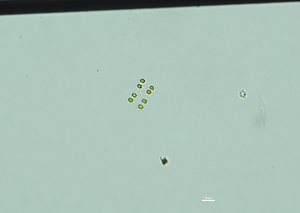Merismopedia sp.
Key to families
- Cells solitary or forming irregular, flat or spherical mucilaginous colonies, cell division in two planes in successive generations ... Merismopediaceae (Genera included in this volume: Aphanocapsa, Coelosphaerium, Gomphosphaeria, Merismopedia, Pannus, Snowella, Synechocystis, Woronichinia)



Project
Perfect Execution
Project
A Real Success
Project
Exceptional Achievement



Project
Perfect Execution
Project
A Real Success
Project
Exceptional Achievement



Project
Perfect Execution
Project
A Real Success
Project
Exceptional Achievement



Project
Perfect Execution
Project
A Real Success
Project
Exceptional Achievement



Project
Perfect Execution
Project
A Real Success
Project
Exceptional Achievement

Project
Perfect Execution
Key to species
1. Colonies planktonic .....................................................................................................................................................2
- Colonies epiphytic metaphytic, or benthic, non-planktonic........................................................................................ 7
2. Cells with aerotopes, 1.8–2.1 μm wide .....................................................................................................M. marssonii
- Cells without aerotopes ................................................................................................................................................3
3. Cells < 2 μm in diameter ............................................................................................................................................ 4
- Cells > 2 μm in diameter .............................................................................................................................................5
4. Colonies small, quadrate, 4–32 celled, with relatively densely arranged cells; mucilage hyaline, 2–5 μm broad, generally indistinct; cells rarely with individual gelatinous envelopes, 0.6–1.2 μm in diameter ...............M. minutissima
- Colonies flat, rectangular, composed of 16 to > 100 relatively densely aggregated cells with individual mucilaginous sheaths; cells 0.8–1.6 (–2.0) μm in diameter ...........................................................................................M. tenuissima
5. Colonies with cells regularly and closely arranged in perpendicular rows ................................................................ 6
- Colonies flat or slightly curved with 8–16 very sparsely dispersed cells in ± perpendicular rows; distance between cells within groups 1.6–5.3 μm, and 5–8 μm between adjacent rows; cells 1.8–2.8 μm in diameter .................................................................................M. danubiana
6. Colonies generally large (up to 4000 celled), tabular, rectangular; mucilage thick, distinct, cells spherical or broadly oval before division, sub-spherical after division, 5–8 (–9) μm wide .........................................................M. elegans
- Colonies generally small, 2–16 up to 64 celled (rarely more), usually in regular rows; mucilage distinct or diffluent; cells (2.0–) 2.5–3.5 μm in diameter .......M. punctata
7. Cells loosely arranged in perpendicular rows ..................................................................................................M. sp. A
- Cells spaced closely......................................................................................................................................................8
8. Colonies with mucilage which is generally indistinct; cells 3.5–5.5 μm × 2.9–5.0 (–5.3) μm in diameter with refractile granules............................................................................................................................................M. sphagnicola
- Colonies with distinct mucilage, extending beyond the cell margin .......................................................................... 9
9. Colonies enveloped in a thin firm, gelatinous envelope; cells arranged in perpendicular rows, in outline quadrangular-rounded to rectangular in shape, sometimes slightly alternating in rows, 4.0–6.5 (–7.0) μm × 4.0–4.4 μm........................................................................................................................................................M. angularis
- Colonies with relatively densely and regularly arranged cells, sometimes consisting of subcolonies; nucilage sometimes diffluent, slightly extending beyond the marginal cells; cells (2.8–) 3.0–5.0 (–6.0) μm in diameter ........................................................................................................................................................M. glauca
Key to genera
1. Cells solitary ........................................................................................................................................... Synechocystis
- Cells in various colonial arrangements ........................................................................................................................2
2. Cells arranged at the periphery of the colony.................................................................................................... Pannus
- Cells regularly or irregularly arranged throughout the colony.....................................................................................3
3. Colonies amorphous, irregular with cells irregularly arranged ...............................................................Aphanocapsa
- Colonies plate-like with cells in regular tabular arrangement ................................................................Merismopedia